Phân tích nguyên tố vết lắng đọng trong không khí qua rêu barbula indica tại thành phố bảo lộc sử dụng kỹ thuật huỳnh quang tia X phản xạ toàn phần
Trong nghiên cứu này, kỹ thuật huỳnh quang tia X phản xạ toàn phần (TXRF) được ứng dụng
đã xác định được 24 nguyên tố, bao gồm: Al, P, S, Cl, K, Sr, Sc, Ti, Mn, Fe, Co, Cu, Zn, As,
Br, Ba, La, Eu, Tb, Dy, Ta, Pb, Th, và U trên rêu Barbula Indica tại thành phố Bảo Lộc (Việt
Nam) từ tháng mười một năm 2019 đến tháng ba năm 2020. Kết quả cũng đã dự đoán những
nguồn ô nhiễm mang lại. Ở nghiên cứu này cho thấy việc sử dụng mẫu rêu có sẵn, và kỹ thuật
TXRF là hiệu quả, rất thuận lợi để xác định sự lắng động các nguyên tố vết trong không khí
cho những quốc gia đang phát triển, đặc biệt là Việt Nam và các nước Châu Á.
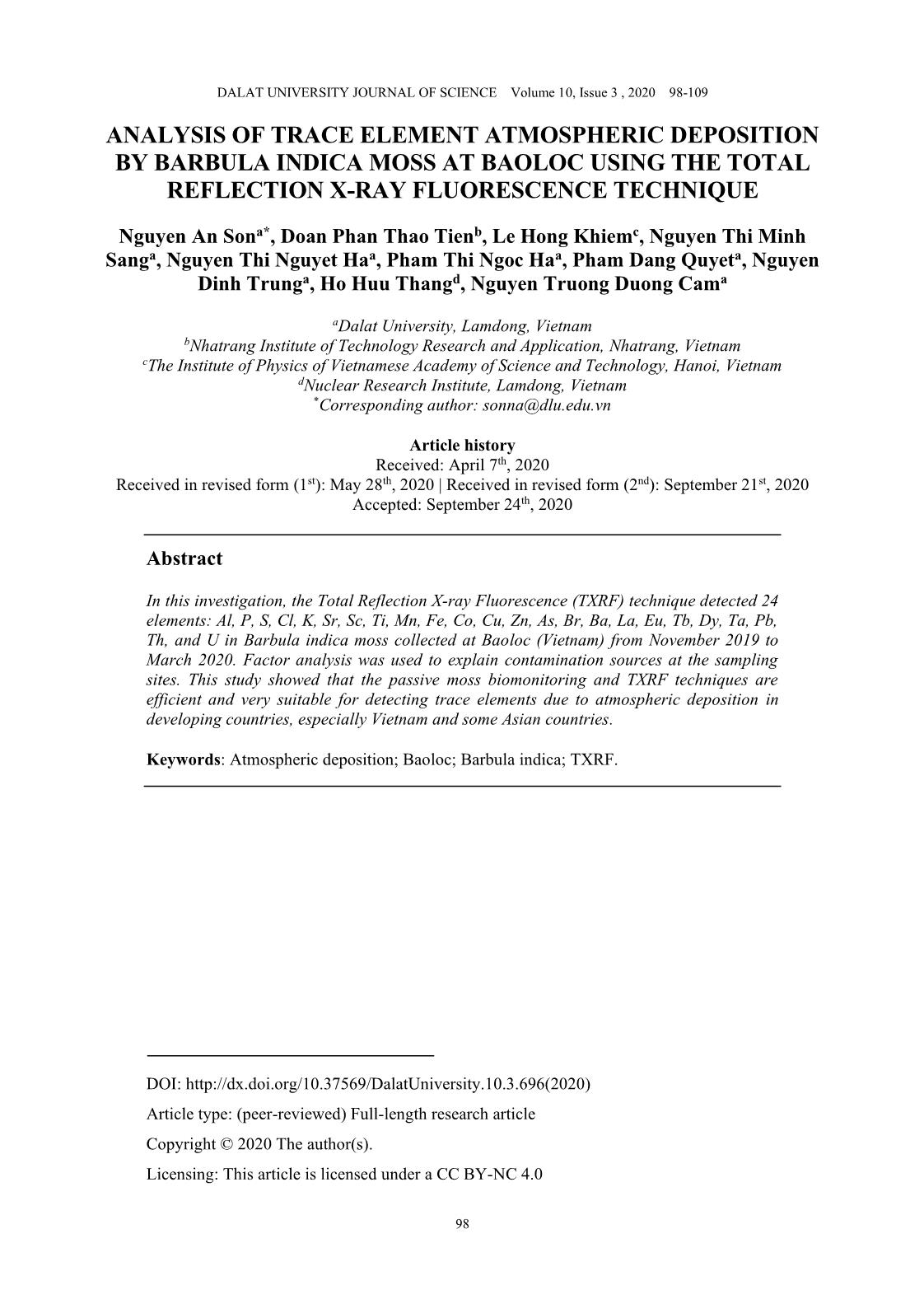
Trang 1
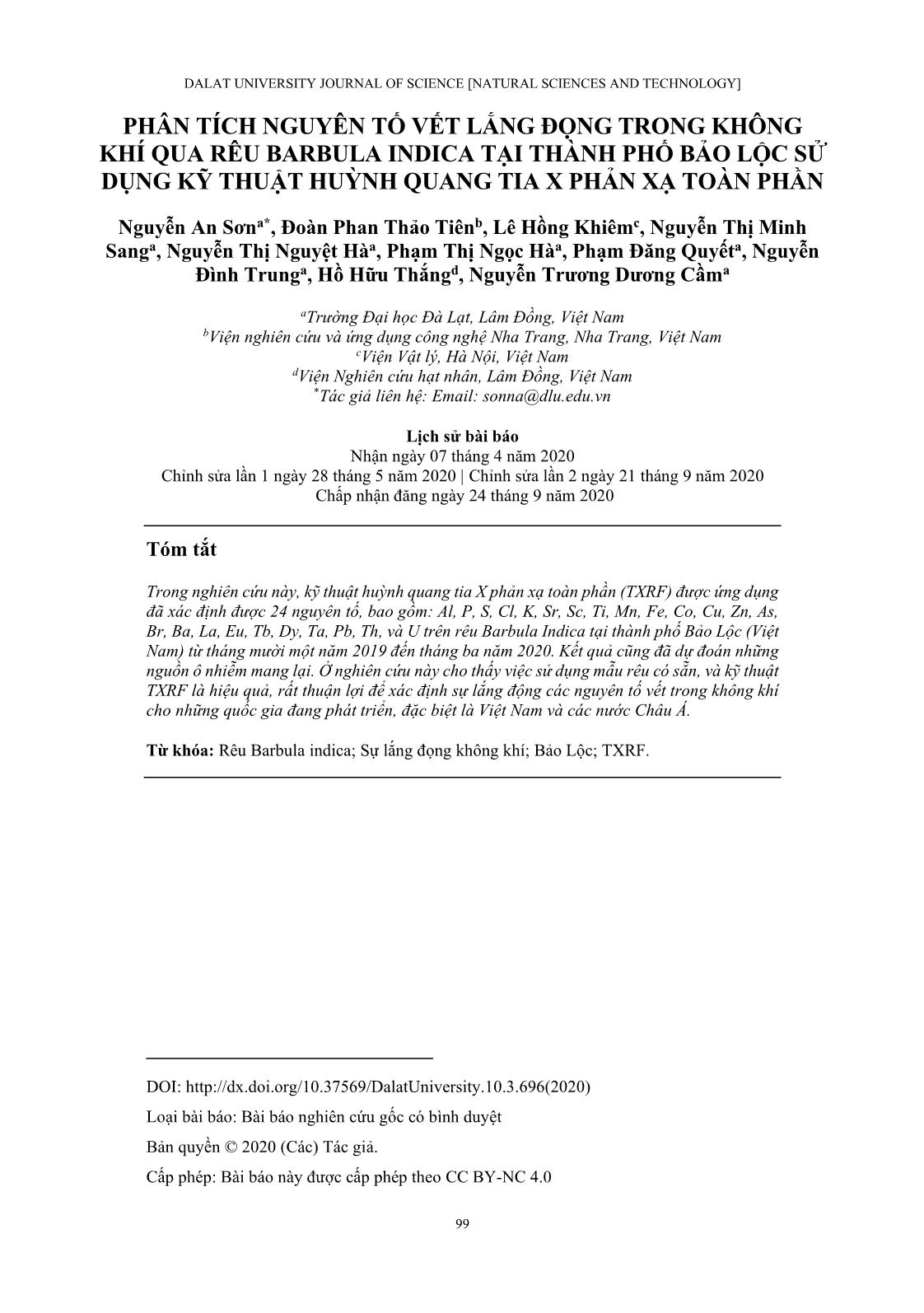
Trang 2
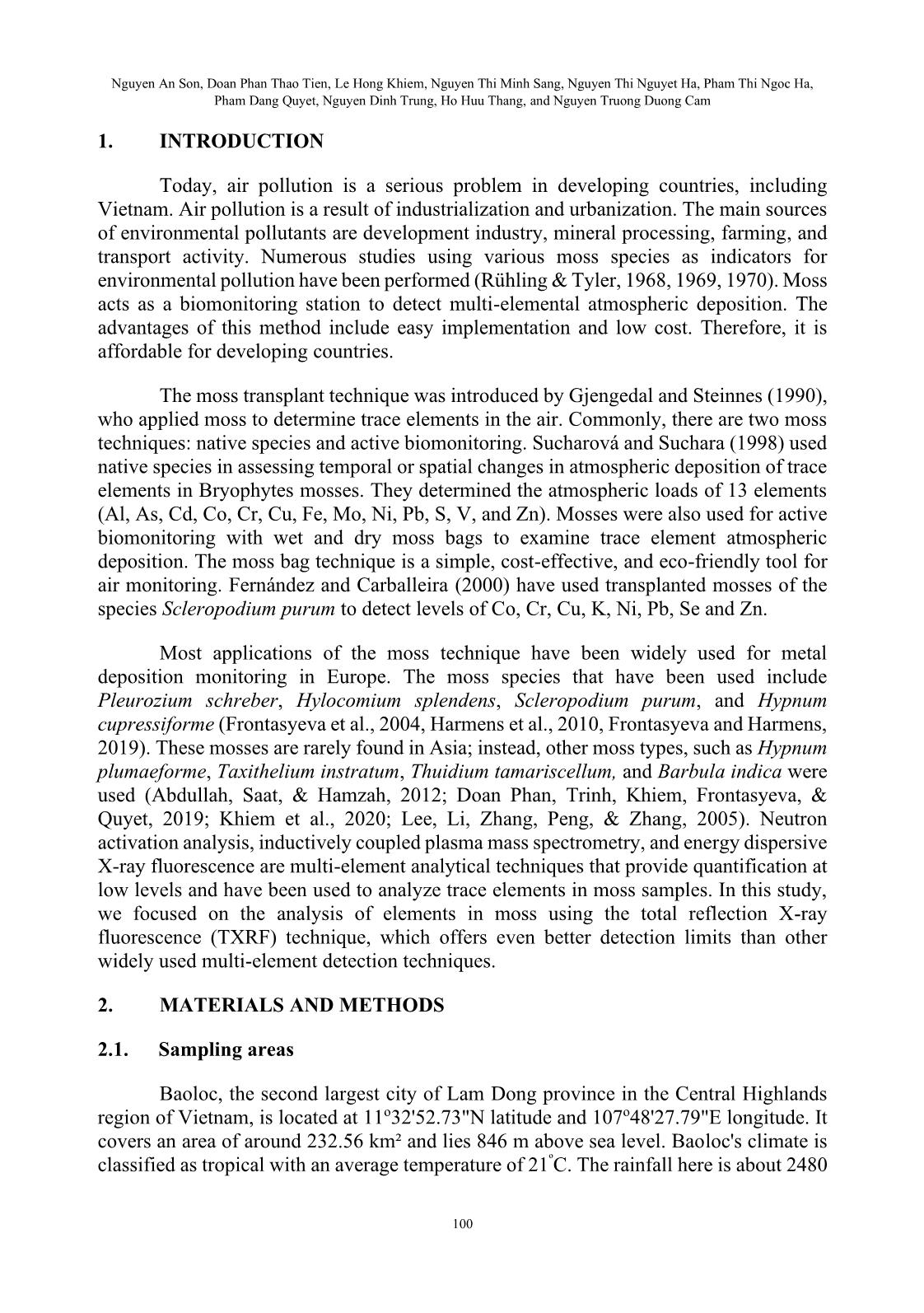
Trang 3
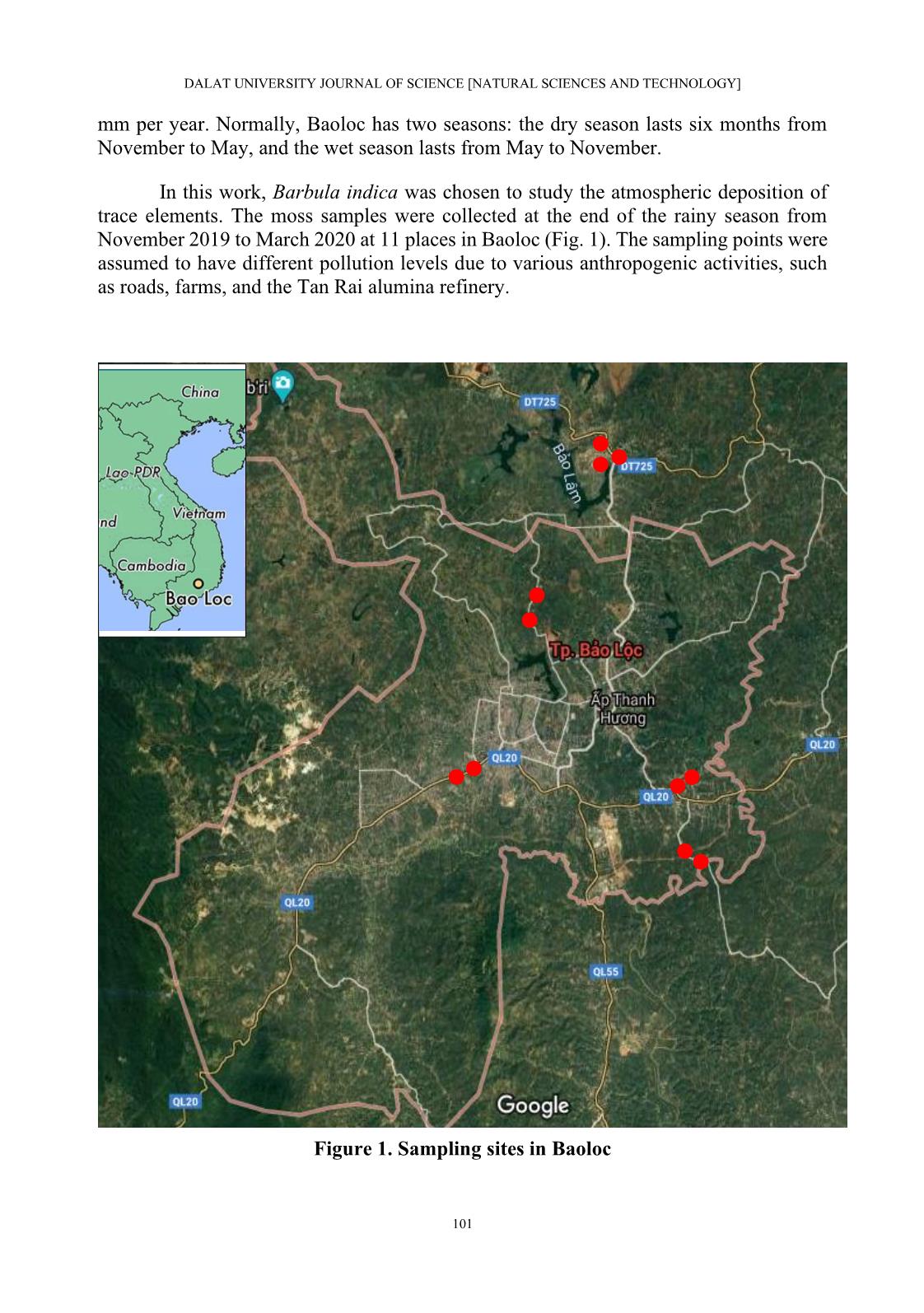
Trang 4
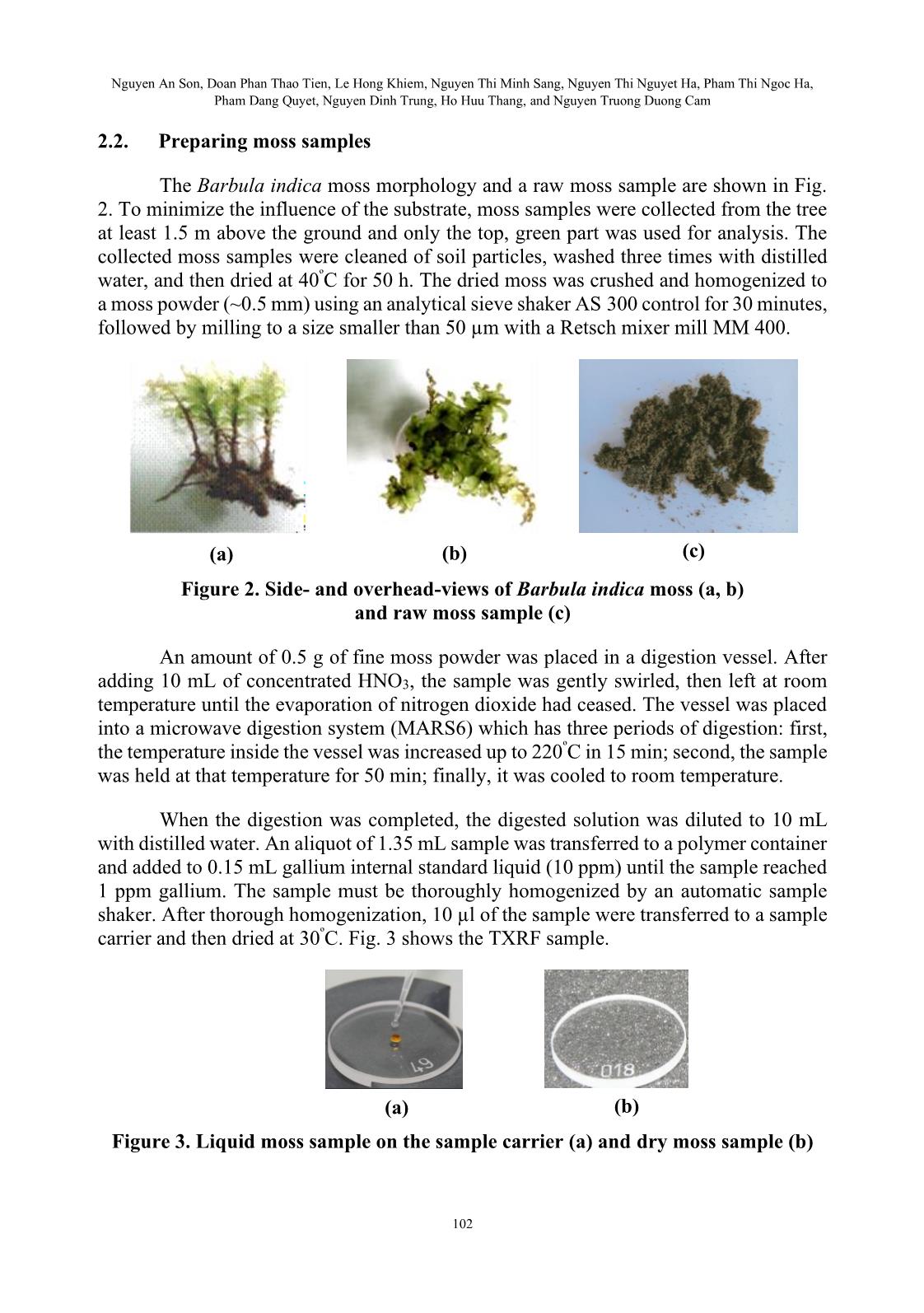
Trang 5
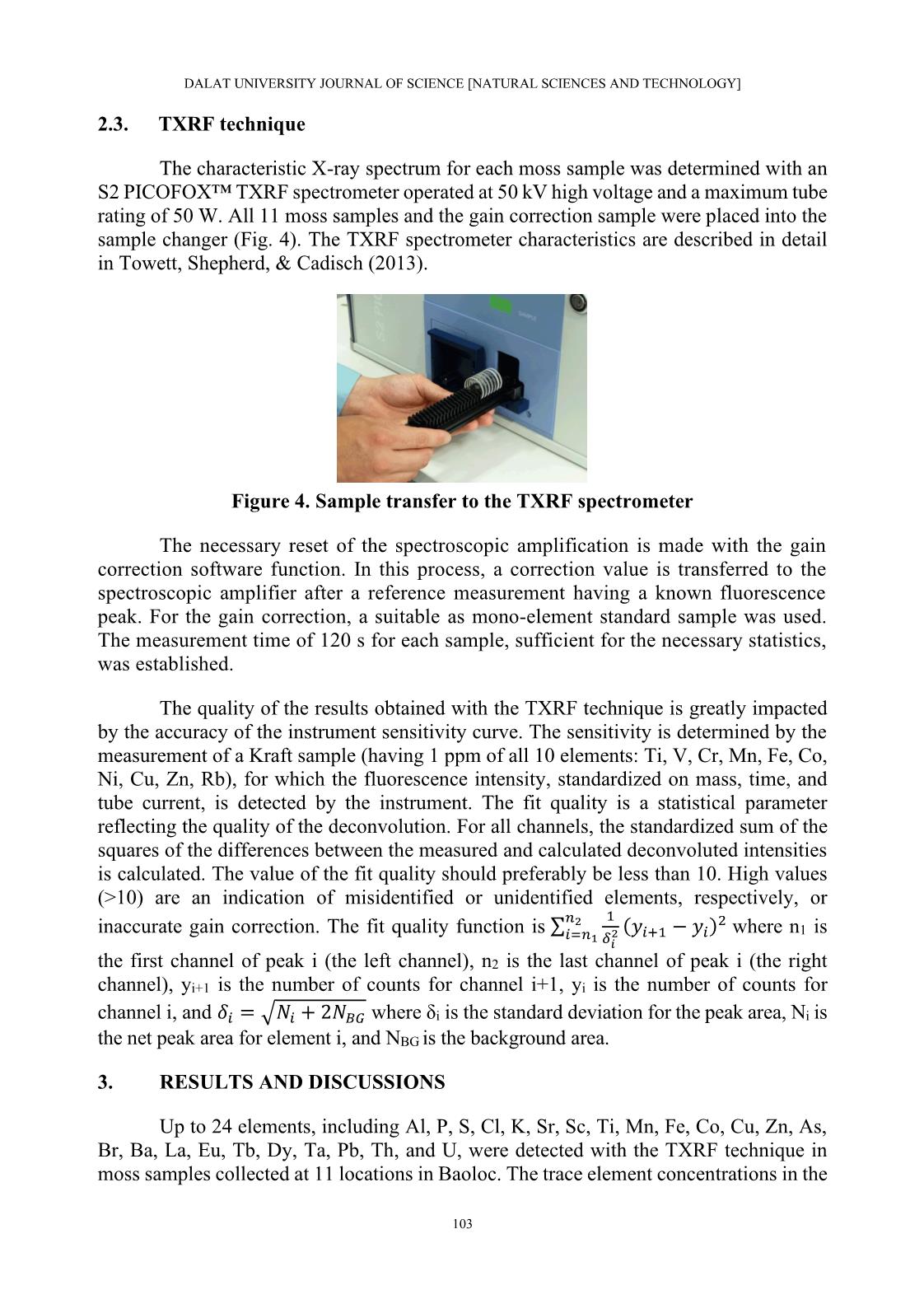
Trang 6
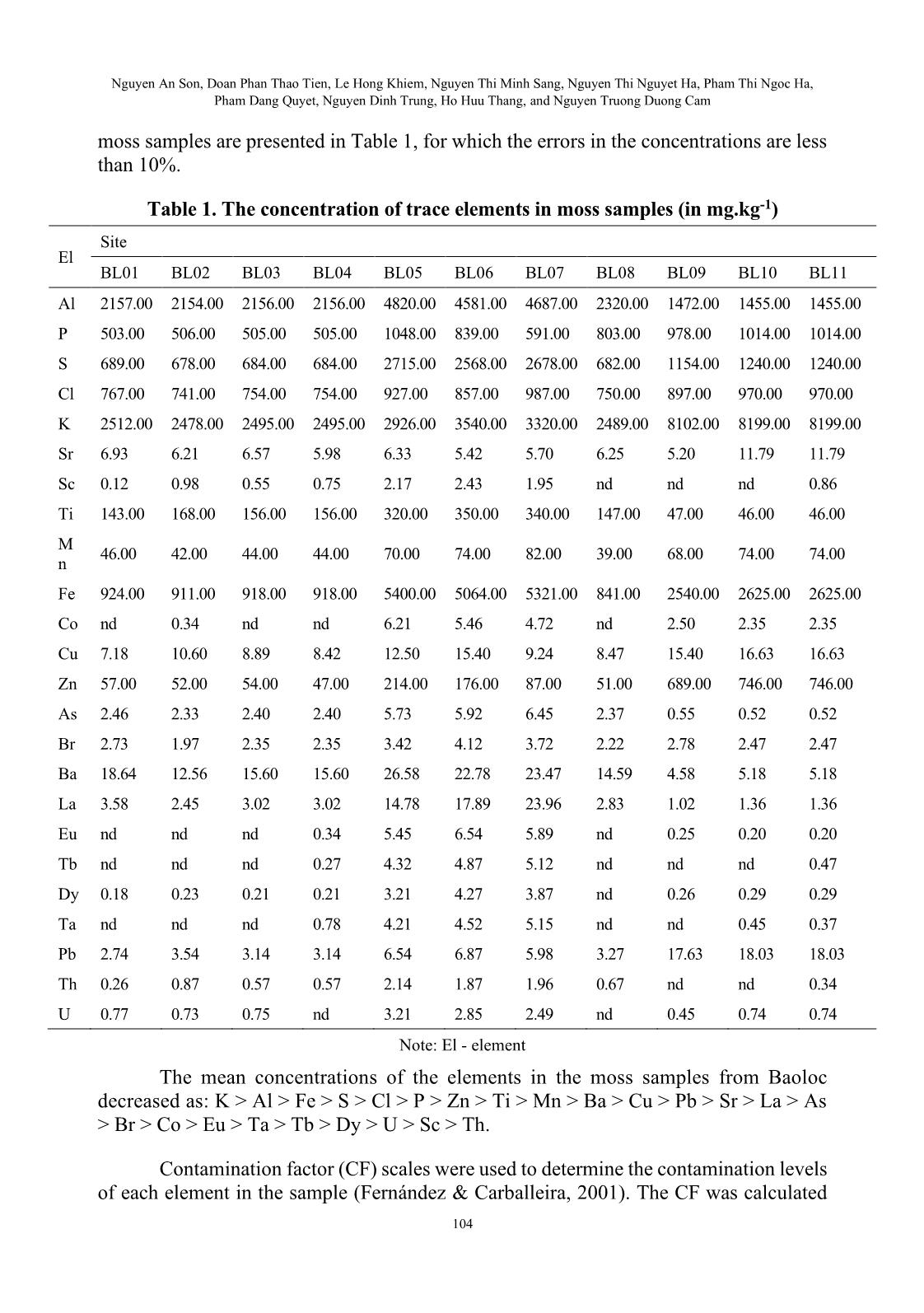
Trang 7
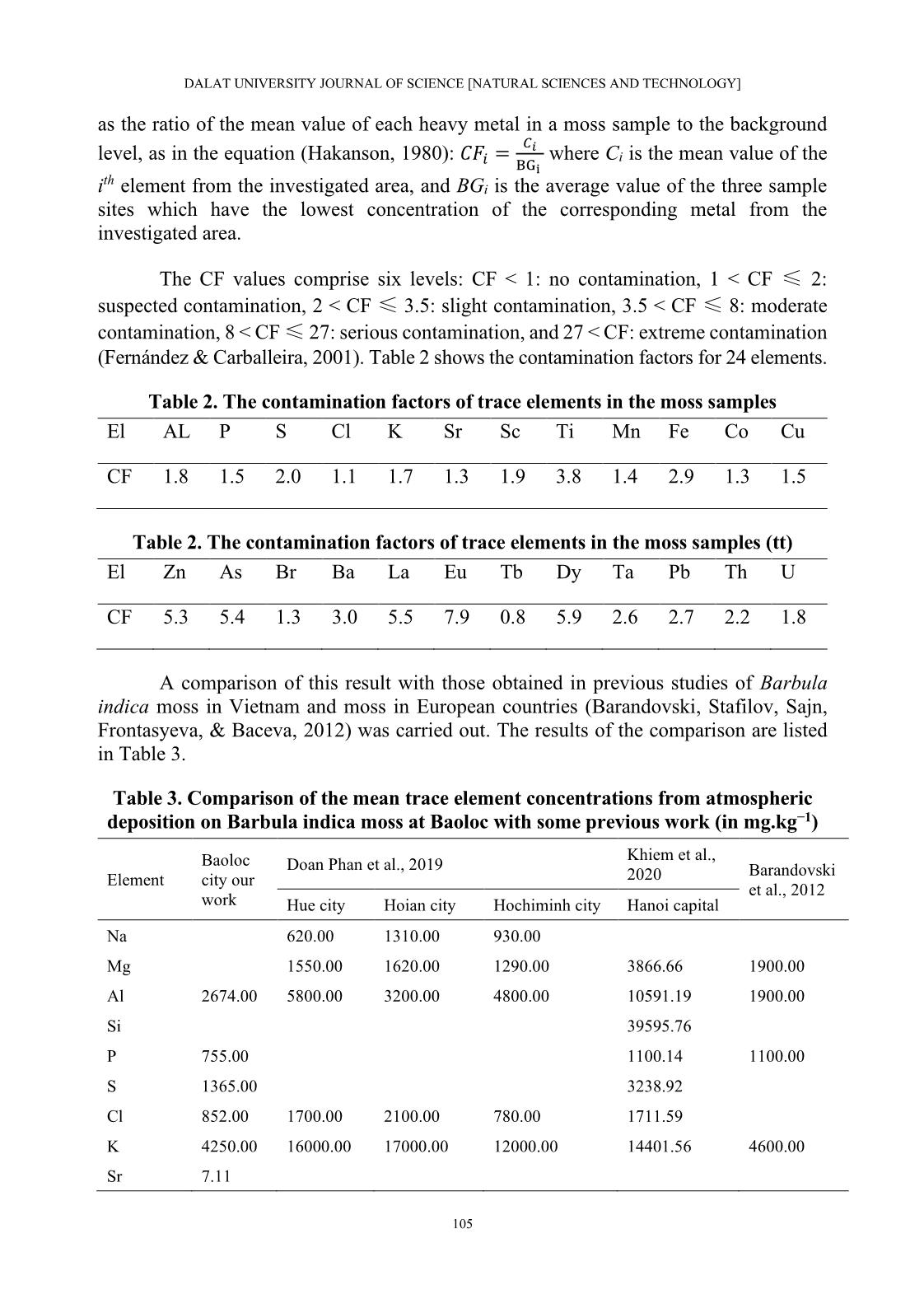
Trang 8

Trang 9
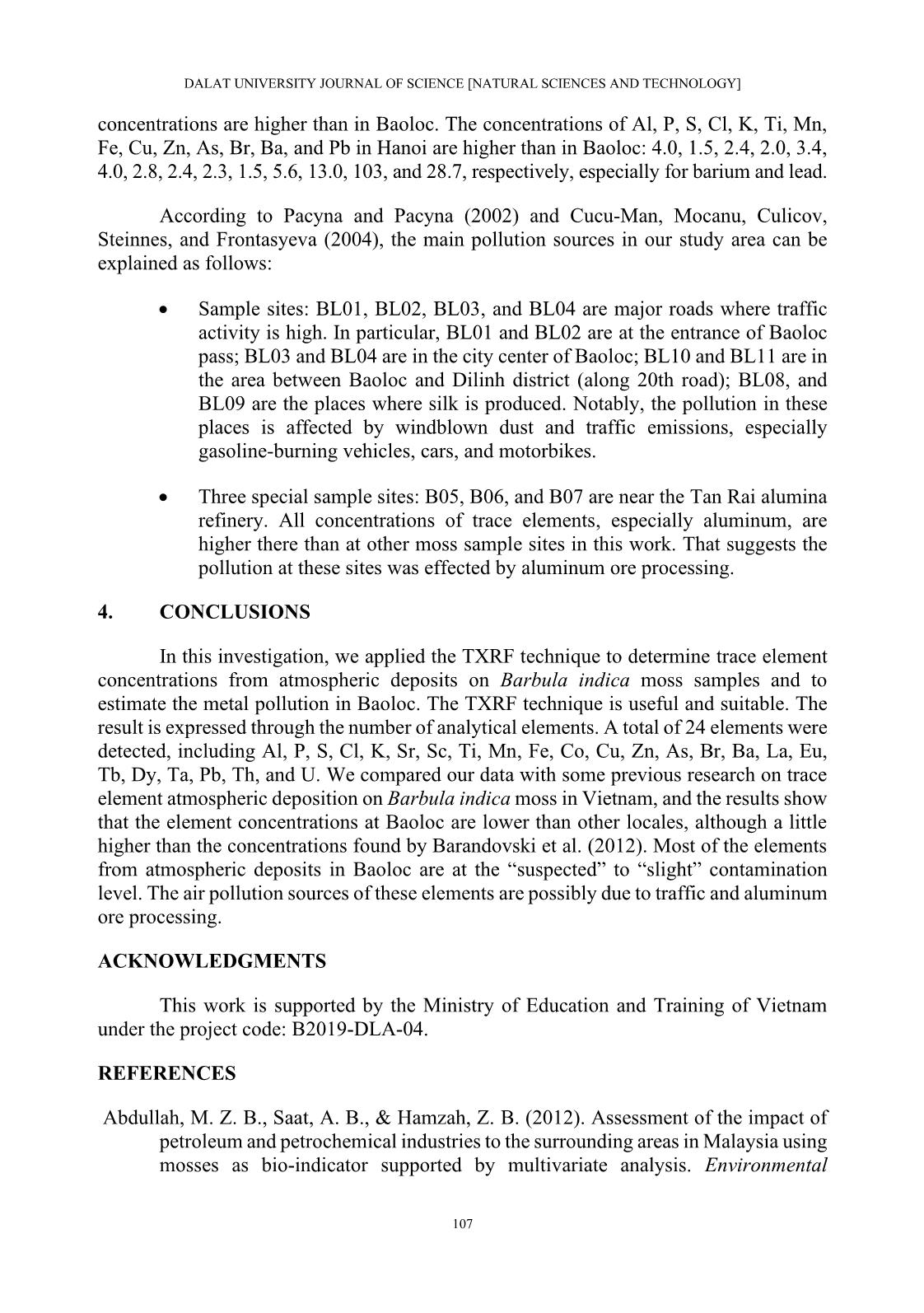
Trang 10
Tải về để xem bản đầy đủ
Bạn đang xem 10 trang mẫu của tài liệu "Phân tích nguyên tố vết lắng đọng trong không khí qua rêu barbula indica tại thành phố bảo lộc sử dụng kỹ thuật huỳnh quang tia X phản xạ toàn phần", để tải tài liệu gốc về máy hãy click vào nút Download ở trên
Tóm tắt nội dung tài liệu: Phân tích nguyên tố vết lắng đọng trong không khí qua rêu barbula indica tại thành phố bảo lộc sử dụng kỹ thuật huỳnh quang tia X phản xạ toàn phần
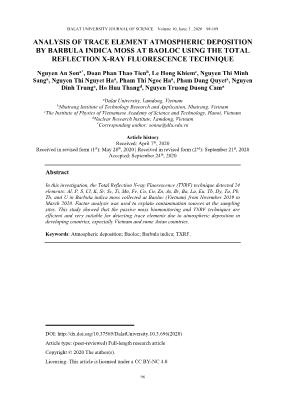
he standardized sum of the squares of the differences between the measured and calculated deconvoluted intensities is calculated. The value of the fit quality should preferably be less than 10. High values (>10) are an indication of misidentified or unidentified elements, respectively, or inaccurate gain correction. The fit quality function is ∑ 1 𝛿𝑖 2 (𝑦𝑖+1 − 𝑦𝑖) 2𝑛2 𝑖=𝑛1 where n1 is the first channel of peak i (the left channel), n2 is the last channel of peak i (the right channel), yi+1 is the number of counts for channel i+1, yi is the number of counts for channel i, and 𝛿𝑖 = √𝑁𝑖 + 2𝑁𝐵𝐺 where δi is the standard deviation for the peak area, Ni is the net peak area for element i, and NBG is the background area. 3. RESULTS AND DISCUSSIONS Up to 24 elements, including Al, P, S, Cl, K, Sr, Sc, Ti, Mn, Fe, Co, Cu, Zn, As, Br, Ba, La, Eu, Tb, Dy, Ta, Pb, Th, and U, were detected with the TXRF technique in moss samples collected at 11 locations in Baoloc. The trace element concentrations in the Nguyen An Son, Doan Phan Thao Tien, Le Hong Khiem, Nguyen Thi Minh Sang, Nguyen Thi Nguyet Ha, Pham Thi Ngoc Ha, Pham Dang Quyet, Nguyen Dinh Trung, Ho Huu Thang, and Nguyen Truong Duong Cam 104 moss samples are presented in Table 1, for which the errors in the concentrations are less than 10%. Table 1. The concentration of trace elements in moss samples (in mg.kg-1) El Site BL01 BL02 BL03 BL04 BL05 BL06 BL07 BL08 BL09 BL10 BL11 Al 2157.00 2154.00 2156.00 2156.00 4820.00 4581.00 4687.00 2320.00 1472.00 1455.00 1455.00 P 503.00 506.00 505.00 505.00 1048.00 839.00 591.00 803.00 978.00 1014.00 1014.00 S 689.00 678.00 684.00 684.00 2715.00 2568.00 2678.00 682.00 1154.00 1240.00 1240.00 Cl 767.00 741.00 754.00 754.00 927.00 857.00 987.00 750.00 897.00 970.00 970.00 K 2512.00 2478.00 2495.00 2495.00 2926.00 3540.00 3320.00 2489.00 8102.00 8199.00 8199.00 Sr 6.93 6.21 6.57 5.98 6.33 5.42 5.70 6.25 5.20 11.79 11.79 Sc 0.12 0.98 0.55 0.75 2.17 2.43 1.95 nd nd nd 0.86 Ti 143.00 168.00 156.00 156.00 320.00 350.00 340.00 147.00 47.00 46.00 46.00 M n 46.00 42.00 44.00 44.00 70.00 74.00 82.00 39.00 68.00 74.00 74.00 Fe 924.00 911.00 918.00 918.00 5400.00 5064.00 5321.00 841.00 2540.00 2625.00 2625.00 Co nd 0.34 nd nd 6.21 5.46 4.72 nd 2.50 2.35 2.35 Cu 7.18 10.60 8.89 8.42 12.50 15.40 9.24 8.47 15.40 16.63 16.63 Zn 57.00 52.00 54.00 47.00 214.00 176.00 87.00 51.00 689.00 746.00 746.00 As 2.46 2.33 2.40 2.40 5.73 5.92 6.45 2.37 0.55 0.52 0.52 Br 2.73 1.97 2.35 2.35 3.42 4.12 3.72 2.22 2.78 2.47 2.47 Ba 18.64 12.56 15.60 15.60 26.58 22.78 23.47 14.59 4.58 5.18 5.18 La 3.58 2.45 3.02 3.02 14.78 17.89 23.96 2.83 1.02 1.36 1.36 Eu nd nd nd 0.34 5.45 6.54 5.89 nd 0.25 0.20 0.20 Tb nd nd nd 0.27 4.32 4.87 5.12 nd nd nd 0.47 Dy 0.18 0.23 0.21 0.21 3.21 4.27 3.87 nd 0.26 0.29 0.29 Ta nd nd nd 0.78 4.21 4.52 5.15 nd nd 0.45 0.37 Pb 2.74 3.54 3.14 3.14 6.54 6.87 5.98 3.27 17.63 18.03 18.03 Th 0.26 0.87 0.57 0.57 2.14 1.87 1.96 0.67 nd nd 0.34 U 0.77 0.73 0.75 nd 3.21 2.85 2.49 nd 0.45 0.74 0.74 Note: El - element The mean concentrations of the elements in the moss samples from Baoloc decreased as: K > Al > Fe > S > Cl > P > Zn > Ti > Mn > Ba > Cu > Pb > Sr > La > As > Br > Co > Eu > Ta > Tb > Dy > U > Sc > Th. Contamination factor (CF) scales were used to determine the contamination levels of each element in the sample (Fernández & Carballeira, 2001). The CF was calculated DALAT UNIVERSITY JOURNAL OF SCIENCE [NATURAL SCIENCES AND TECHNOLOGY] 105 as the ratio of the mean value of each heavy metal in a moss sample to the background level, as in the equation (Hakanson, 1980): 𝐶𝐹𝑖 = 𝐶𝑖 BGi where Ci is the mean value of the ith element from the investigated area, and BGi is the average value of the three sample sites which have the lowest concentration of the corresponding metal from the investigated area. The CF values comprise six levels: CF < 1: no contamination, 1 < CF ≤ 2: suspected contamination, 2 < CF ≤ 3.5: slight contamination, 3.5 < CF ≤ 8: moderate contamination, 8 < CF ≤ 27: serious contamination, and 27 < CF: extreme contamination (Fernández & Carballeira, 2001). Table 2 shows the contamination factors for 24 elements. Table 2. The contamination factors of trace elements in the moss samples El AL P S Cl K Sr Sc Ti Mn Fe Co Cu CF 1.8 1.5 2.0 1.1 1.7 1.3 1.9 3.8 1.4 2.9 1.3 1.5 Table 2. The contamination factors of trace elements in the moss samples (tt) El Zn As Br Ba La Eu Tb Dy Ta Pb Th U CF 5.3 5.4 1.3 3.0 5.5 7.9 0.8 5.9 2.6 2.7 2.2 1.8 A comparison of this result with those obtained in previous studies of Barbula indica moss in Vietnam and moss in European countries (Barandovski, Stafilov, Sajn, Frontasyeva, & Baceva, 2012) was carried out. The results of the comparison are listed in Table 3. Table 3. Comparison of the mean trace element concentrations from atmospheric deposition on Barbula indica moss at Baoloc with some previous work (in mg.kg−1) Element Baoloc city our work Doan Phan et al., 2019 Khiem et al., 2020 Barandovski et al., 2012 Hue city Hoian city Hochiminh city Hanoi capital Na 620.00 1310.00 930.00 Mg 1550.00 1620.00 1290.00 3866.66 1900.00 Al 2674.00 5800.00 3200.00 4800.00 10591.19 1900.00 Si 39595.76 P 755.00 1100.14 1100.00 S 1365.00 3238.92 Cl 852.00 1700.00 2100.00 780.00 1711.59 K 4250.00 16000.00 17000.00 12000.00 14401.56 4600.00 Sr 7.11 Nguyen An Son, Doan Phan Thao Tien, Le Hong Khiem, Nguyen Thi Minh Sang, Nguyen Thi Nguyet Ha, Pham Thi Ngoc Ha, Pham Dang Quyet, Nguyen Dinh Trung, Ho Huu Thang, and Nguyen Truong Duong Cam 106 Table 3. Comparison of the mean trace element concentrations from atmospheric deposition on Barbula indica moss at Baoloc with some previous work (in mg.kg−1) (tt) Element Baoloc city our work Doan Phan et al., 2019 Khiem et al., 2020 Barandovski et al., 2012 Hue city Hoian city Hochiminh city Hanoi capital Sc 0.89 1.09 0.80 1.81 Ti 174.00 271.00 205.00 524.00 691.60 V 12.20 5.11 8.08 3.50 Cr 11.00 6.80 19.90 26.73 3.50 Mn 60.00 74.00 88.00 77.00 170.95 130.00 Fe 2553.00 3720.00 4810.00 5430.00 6025.18 1500.00 Co 2.18 1.40 1.01 3.28 Ni 4.20 2.70 9.50 4.42 3.50 Cu 11.76 27.20 3.50 Zn 265.00 126.00 254.00 178.00 397.53 20.00 As 2.88 2.30 3.00 4.10 16.11 Se 1.40 0.70 0.39 Br 2.78 10.40 7.70 12.80 36.11 Kr Rb 151.17 Sb 1.40 0.89 1.00 Cs 1.58 1.18 5.30 Ba 14.98 58.00 83.00 101.00 1545.55 34.00 La 6.84 3.10 2.24 5.60 Ce 6.20 4.20 11.70 Sm 0.51 0.35 1.15 Eu 1.72 Tb 1.37 Dy 1.18 Ta 1.41 0.09 0.07 0.15 Pb 8.08 231.55 4.60 Th 0.84 1.78 0.86 1.49 U 1.16 0.62 0.23 1.10 For Hue, Hoian, and Hochiminh City, the element concentrations are near the values found in our work and some are slightly higher. For Hanoi, all element DALAT UNIVERSITY JOURNAL OF SCIENCE [NATURAL SCIENCES AND TECHNOLOGY] 107 concentrations are higher than in Baoloc. The concentrations of Al, P, S, Cl, K, Ti, Mn, Fe, Cu, Zn, As, Br, Ba, and Pb in Hanoi are higher than in Baoloc: 4.0, 1.5, 2.4, 2.0, 3.4, 4.0, 2.8, 2.4, 2.3, 1.5, 5.6, 13.0, 103, and 28.7, respectively, especially for barium and lead. According to Pacyna and Pacyna (2002) and Cucu-Man, Mocanu, Culicov, Steinnes, and Frontasyeva (2004), the main pollution sources in our study area can be explained as follows: • Sample sites: BL01, BL02, BL03, and BL04 are major roads where traffic activity is high. In particular, BL01 and BL02 are at the entrance of Baoloc pass; BL03 and BL04 are in the city center of Baoloc; BL10 and BL11 are in the area between Baoloc and Dilinh district (along 20th road); BL08, and BL09 are the places where silk is produced. Notably, the pollution in these places is affected by windblown dust and traffic emissions, especially gasoline-burning vehicles, cars, and motorbikes. • Three special sample sites: B05, B06, and B07 are near the Tan Rai alumina refinery. All concentrations of trace elements, especially aluminum, are higher there than at other moss sample sites in this work. That suggests the pollution at these sites was effected by aluminum ore processing. 4. CONCLUSIONS In this investigation, we applied the TXRF technique to determine trace element concentrations from atmospheric deposits on Barbula indica moss samples and to estimate the metal pollution in Baoloc. The TXRF technique is useful and suitable. The result is expressed through the number of analytical elements. A total of 24 elements were detected, including Al, P, S, Cl, K, Sr, Sc, Ti, Mn, Fe, Co, Cu, Zn, As, Br, Ba, La, Eu, Tb, Dy, Ta, Pb, Th, and U. We compared our data with some previous research on trace element atmospheric deposition on Barbula indica moss in Vietnam, and the results show that the element concentrations at Baoloc are lower than other locales, although a little higher than the concentrations found by Barandovski et al. (2012). Most of the elements from atmospheric deposits in Baoloc are at the “suspected” to “slight” contamination level. The air pollution sources of these elements are possibly due to traffic and aluminum ore processing. ACKNOWLEDGMENTS This work is supported by the Ministry of Education and Training of Vietnam under the project code: B2019-DLA-04. REFERENCES Abdullah, M. Z. B., Saat, A. B., & Hamzah, Z. B. (2012). Assessment of the impact of petroleum and petrochemical industries to the surrounding areas in Malaysia using mosses as bio-indicator supported by multivariate analysis. Environmental Nguyen An Son, Doan Phan Thao Tien, Le Hong Khiem, Nguyen Thi Minh Sang, Nguyen Thi Nguyet Ha, Pham Thi Ngoc Ha, Pham Dang Quyet, Nguyen Dinh Trung, Ho Huu Thang, and Nguyen Truong Duong Cam 108 Monitoring and Assessment, 184, 3959-3969. https://link.springer.com/article /10.1007/s10661-011-2236-y. Barandovski, L., Stafilov, T., Sajn, R., Frontasyeva, M., & Baceva, K. (2012). Air pollution study in Macedonia using a moss biomonitoring technique, ICP-AES and AAS. Macedonian Journal of Chemistry and Chemical Engineering, 32(1), 89-107. https://mjcce.org.mk/index.php/MJCCE/article/view/137. Cucu-Man, S., Mocanu, R., Culicov, O., Steinnes, E., & Frontasyeva, M. (2004). Atmospheric deposition of metals in Romania studied by biomonitoring using the epiphytic moss hypnum cupressiforme. International Journal of Environmental Analytical Chemistry, 84(11), 845-854. https://doi.org/10.1080/03067310420002 68152. Doan Phan, T. T., Trinh, T. T. M., Khiem, L. H., Frontasyeva, M. V., & Quyet, N. H. (2019). Study of airborne trace element pollution in Central and Southern Vietnam using moss (Barbula indica) technique and neutron activation analysis. Asia- Pacific Journal of Atmospheric Sciences, 55, 247-253. https://doi.org/10.1007 /s13143-018-0065-4. Fernández, J. A., & Carballeira, A. (2000). Differences in the responses of native and transplanted to atmospheric pollution: A possible role of selenium. Environmental Pollution, 110(1), 73-78. https://doi.org/10.1016/S0269-7491(99)00278-X. Fernández, J. A., & Carballeira, A. (2001). A comparison of indigenous mosses and topsoils for use in monitoring atmospheric heavy metal deposition in Galicia (Northwest Spain). Environmental Pollution. 114(3), 431-441, https://doi.org/10. 1016/S0269-7491(00)00229-3. Frontasyeva, M. & Harmens, H. (2019). Monitoring of atmospheric deposition of heavy metals, nitrogen and pops in Europe using bryophytes. Retrieved from https://icpvegetation.ceh.ac.uk/sites/default/files/ICP%20Vegetation%20moss% 20monitoring%20manual%202020.pdf. Frontasyeva, M. V., Galinskaya, T. Y., Krmar, M., Matavuly, M., Palov, S. S., Povtoreyko, Stainnes, E. (2004). Atmospheric deposition of heavy metals in northern Serbia and Bosnia-Herzegovina studied by the moss biomonitoring, neutronactivation analysis and GIS technology. Journal of Radioanalytical and Nuclear Chemistry, 259, 141-147. https://link.springer.com/article/10.1023/B: JRNC.0000015819.67830.60. Gjengedal, E., & Steinnes, E. (1990). Uptake of metal ions in moss from artificial precipitation. Environmental Monitoring and Assessment, 14, 77-87. https://link.springer.com/article/10.1007/BF00394359. Hakanson, L. (1980). An ecological risk index for aquatic pollution control: A sedimentological approach. Water Research, 14, 975-1001. https://doi.org/10. 1016/0043-1354(80)90143-8. Harmens, H., Norris, D. A., Steinnes, E., Kubin, E., Piispanen, J., Alber, R., Zechmeister, H. G. (2010). Mosses as biomonitors of atmosphericheavy metal DALAT UNIVERSITY JOURNAL OF SCIENCE [NATURAL SCIENCES AND TECHNOLOGY] 109 deposition: Spatial patterns and temporal trends in Europe. Environmental Pollution, 158(10), 3144-3156. https://doi.org/10.1016/j.envpol.2010.06.039. Khiem, L. H., Sera, K., Hosokawa, T., Quyet, N. H., Frontasyeva, M. V., Trinh, T. T. M., Tien, D. P. T. (2020). Assessment of atmospheric deposition of metals in Ha Noi using the moss bio-monitoring technique and proton induced X-ray emission. Journal of Radioanalytical and Nuclear Chemistry, 324, 43-54. https://doi.org/ 10.1007/s10967-020-07066-z. Lee, C. S. L., Li, X., Zhang, G., Peng, X., & Zhang, L. (2005). Biomonitoring of trace metals in the atmosphere using moss (Hypnum plumaeforme) in the Nanling Mountains and the Pearl River Delta, Southern China. Atmospheric Environment, 39(3), 397-407. https://doi.org/10.1016/j.atmosenv.2004.09.067. Pacyna, J. M., & Pacyna, E. G. (2002). An assessment of global and regional emissions of trace metals to the atmosphere from anthropogenic sources worldwide. Environmental Reviews, 9(4), 269-298. https://doi.org/10.1139/a01-012. Rühling, Å., & Tyler, G. (1968). An ecological approach to the lead problem. Botaniska Notiser, 121, 321-342. Rühling, Å. & Tyler, G. (1969). Ecology of heavy metals-a regional and historical study. Botaniska Notiser, 122, 248-259. Rühling, Å. & Tyler, G. (1970). Sorption and retention of heavy metals in the woodland moss Hylocomium splendens (Hedw.) Br. et Sch. Oikos, 21(1), 92-97. Sucharová, J., & Suchara, I. (1998). Atmospheric deposition levels of chosen elements in the Czech Republic determined in the framework of the International Bryomonitoring Program 1995. Science of The Total Environment, 223(1), 37-52. https://doi.org/10.1016/S0048-9697(98)00306-4. Towett, E. T., Shepherd, K. D., & Cadisch, G. (2013). Quantification of total element concentrations in soils using total X-ray fluorescence spectroscopy (TXRF). Science of The Total Environment. 463-464, 374-388. https://doi.org/10.1016/ j.scitotenv.2013.05.068.
File đính kèm:
 phan_tich_nguyen_to_vet_lang_dong_trong_khong_khi_qua_reu_ba.pdf
phan_tich_nguyen_to_vet_lang_dong_trong_khong_khi_qua_reu_ba.pdf

